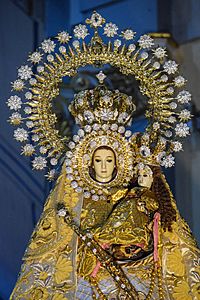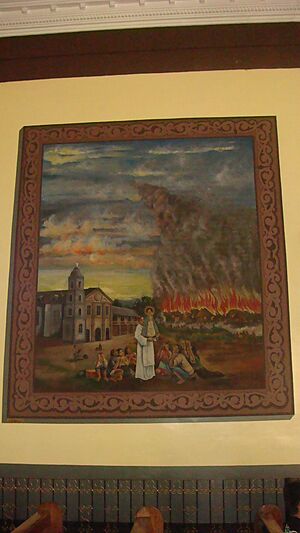Our Lady of Manaoag facts for kids
Quick facts for kids Our Lady of the Most Holy Rosary of ManaoagNuestra Señora del Santísimo Rosario de Manaoag Virgen ng Santo Rosario sa Manaoag |
|
|---|---|

The ivory, bejewelled image of Our Lady of Manaoag
|
|
| Location | Manaoag, Pangasinan, Philippines |
| Date | 1610 |
| Witness | (Unnamed man) (Hagiography as Juan de la Cruz) |
| Type | Marian apparition |
| Approval | Pope Pius XI Pope Benedict XVI |
| Shrine | Minor Basilica of Our Lady of the Rosary of Manaoag |
Our Lady of Manaoag is a special name for the Blessed Virgin Mary in the Roman Catholic faith. People honor her in Manaoag, Pangasinan, in the Philippines. Her full title is Our Lady of the Most Holy Rosary of Manaoag.
The statue of Our Lady of Manaoag is made of ivory and silver. It is very old, from the 16th century. You can find it in the Minor Basilica of Our Lady of the Most Holy Rosary of Manaoag. This church is a big place for pilgrims (people who travel for religious reasons). It is managed by the Order of Preachers, also known as the Dominicans.
In 1925, Pope Pius XI gave the statue a special honor called a canonical coronation. Later, in 2011, Pope Benedict XVI made the church a very special place, like the Basilica of Saint Mary Major in Rome. Many people pray to Our Lady of Manaoag for help when they are sick, helpless, or in need. Her feast days are celebrated twice a year: after Easter and in October.
What's in a Name?
The town of Manaoag got its name from a local word. The word mantaoag in the Pangasinense means "to call." This name comes from the root word taoag, which means "call."
The Special Statue
The statue of Our Lady of Manaoag is a 17th-century image of the Virgin Mary holding The Child Jesus. It is kept at the main altar of the Basilica. This statue came to the Philippines from Spain. It traveled by a galleon ship from Acapulco, Mexico, in the early 1600s. Padre Juan de San Jacinto brought it.
Old records from 1610 tell a story about a farmer. He was walking home when he heard a mysterious female voice. He looked up and saw the Virgin Mary on a cloud-covered treetop. She was holding a Rosary in her right hand and The Child Jesus in her left arm. Everything was glowing with a heavenly light.
Mary told the farmer where she wanted her church to be built. So, a chapel was built on that hilltop. This chapel became the center of the town we now know as Manaoag.
The image of Our Lady of the Rosary is shown in different ways around the world. The clothes and style change depending on the culture. However, the Manaoag statue is special because of its unique sculpture and royal decorations.
A copy of the statue also travels to different churches in the Philippines. This allows more people to see and honor it.
Royal Decorations and Safety
The statue of Our Lady of Manaoag and its jeweled crown are very valuable. There have been attempts to steal the jewels from the statue's dress and decorations. These decorations include crowns, halos, rosaries, scepters, and a marshal's baton.
Some of her golden crowns and halos are kept in the church museum. These were given by people who love the Virgin Mary, both from the Philippines and other countries. The museum also displays many beautiful church clothes used by the statue and the Dominican priests. There are also perfumes used to anoint the statue. These are gifts from people who have received blessings.
The statue of Our Lady of Manaoag is kept safe inside a bulletproof glass case. This case is above the main altar. The altar has new wood carvings, a raised platform, and four golden candle holders. The symbol of the Dominicans is placed above the statue's window. This shows their strong devotion to her. The carvings below her throne show important events in the story of Our Lady of Manaoag.
The church has built a staircase for people to get closer to the statue. This staircase leads to the Veneration Room on the second floor, behind the main altar. In this room, people can kneel and pray. They can touch the hem of the statue's clothing through a small glass window. Many people also drop written prayers into a nearby box. After visiting the statue, people can go through a shop that sells religious items.
Honoring Our Lady
Amazing Stories
Some of the earliest amazing stories linked to Our Lady of Manaoag are shown in the church murals. These include the original story of her appearance.
Long ago, during the Spanish era, mountain tribes would burn down villages. Manaoag was one of these villages. People ran to the church for safety. The leader of the attackers climbed over the church fence. He shot flaming arrows at the church. But the building amazingly did not catch fire.
During the Second World War, Japanese forces dropped bombs near the church. The church was only slightly damaged. Four bombs fell above the church. Three landed on the plaza and the front of the church, destroying them. The last bomb fell inside the church but amazingly did not explode. Japanese soldiers did not harm the church because they saw chrysanthemum flowers inside. These flowers are special in their culture.
Other amazing stories linked to Our Lady of Manaoag include:
- Rain falling during dry periods.
- A boy who had died coming back to life through prayer and holy water.
- A fire that started in the church stopping on its own.
- The church resisting attempts to move it to another place.
Many people today still share stories of blessings and help they received. They believe Our Lady of Manaoag helped them. People often travel long distances to pray to her when they need help.
Special Celebrations
The main celebration for Our Lady of Manaoag is on the third Wednesday after Easter. Many pilgrims visit during:
- The Lenten and Easter seasons.
- The month of May.
- The month of October, which is the month of The Holy Rosary.
The universal feast day of Our Lady of The Holy Rosary is celebrated every first Sunday of October. After the afternoon Mass on these days, there is a procession.
Church Activities
Thousands of people come to Manaoag on Saturdays and Sundays. They come to pray, attend Mass, and say the Rosary. They also offer flowers, light candles, and buy religious items. People can also have religious items or vehicles blessed. Holy water is given for free to those with containers.
Blessings of religious items and vehicles happen behind the church after every Mass. Holy water is also available there.
A short morning procession and Scriptural Rosary happen every first Saturday before the 5 a.m. Mass. Many pilgrims attend, especially from Metro Manila and nearby regions. These first Saturday events follow the request made by the Virgin Mary. She asked for these devotions in her third appearance at Fátima in 1917. This was for world peace.
You can offer any of the regular Masses for your own prayers or to give thanks. The 7 a.m. Masses on Fridays (except Good Friday) can be offered for the souls of those who have passed away. You can arrange this at the parish office, the Shrine Museum, or behind the church near the Candle Gallery entrance. You can also offer Mass intentions and donations through the shrine's website.
Church services and religious programs are broadcast on Radyo Manaoag 102.7 FM. You can also listen through the shrine's official website: http://www.manaoagshrine.org.
In Guam
A three-foot copy of the statue of Our Lady of Manaoag was given by a devotee. It traveled to the United States territory of Guam on August 17, 2012. The statue was placed in the Saint Anthony of Padua and Saint Victor Catholic Church in Tamuning, Guam. A special ceremony was held the next day. Many Filipino-Guamanian Catholics attended. The statue traveled as a paid passenger on a United Airlines flight.
See also
 In Spanish: Nuestra Señora de Manáoag para niños
In Spanish: Nuestra Señora de Manáoag para niños
- Roman Catholicism in the Philippines
- Marian apparition
- Our Lady of La Naval, a similar Marian image in Quezon City







